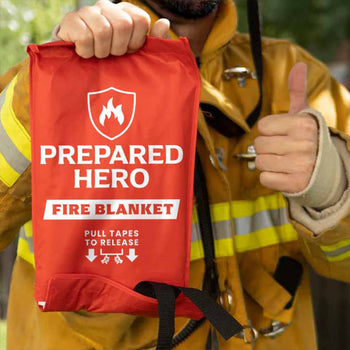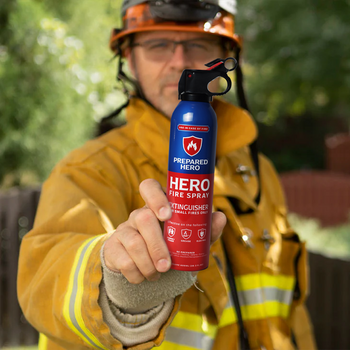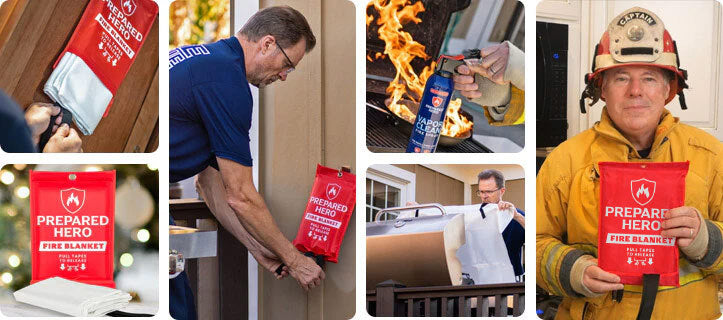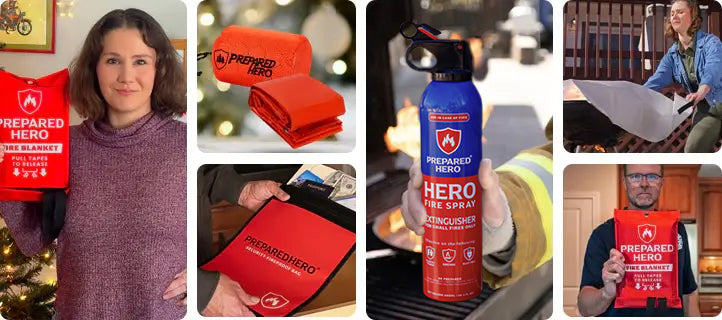Where you put your smoke detectors matters just as much as installing them. Proper placement makes sure they can detect...
When a fire occurs, having an easy-to-grab tool like a fire blanket helps. But can a fire blanket be used on any fire? How about big, scary fires? Are there limitations that we should know about?
Those are great questions and ones worth answering before a fire emergency happens. Let’s break down the uses of a fire blanket to see if it can be used on any type of fire.
What Is a Fire Blanket Used For?

Fire blankets are used to put out small fires. They’re commonly placed in fire-prone areas in the house, including the kitchen, yard, living room, and garage.
In particular, fire blankets are fire-resistant sheets you can use to cover a fire to deprive it of oxygen. Since fire can’t continue burning without oxygen, covering it with a fire blanket that can withstand extreme temperatures extinguishes it quickly.
You can also wrap it around a person whose clothes are on fire. Check out our guide to learn more about how to save someone on fire using a fire blanket. In addition, you can use a fire blanket to protect yourself while moving through a room on fire. Simply wrap yourself, a child, or an adult with the fire blanket as you pass through the affected area.
Where Is a Fire Blanket Commonly Used?

A fire blanket is used in many places, including homes, restaurants, schools, offices, laboratories, and factories. These places have fire hazards that can easily spread fire. Since fire can spread as fast as 30 seconds, containing it at its early stages is the best way to prevent a raging inferno.
Take note: you should have at least one fire blanket in your kitchen because vegetable oil catches fire easily. The same applies to other fire-prone areas in your house. Check out our guide to know exactly how many fire blankets you need at home.
How Does the Type of Fire Affect the Use of Fire Blankets?

Understanding the types of fire helps you choose the right type of fire blanket to use. While most fire blankets put out most types of fire, knowing what works best for your needs helps you extinguish the fire more quickly.
There are six types of fire: Class A, B, C, D, and K.
Class A fires are the most common type of fire. They’re caused by solid items like paper, plastic, wood, or fabric. On the other hand, Class B fires are caused by flammable liquids and gases like paint, alcohol, propane, and butane. Electrical equipment cause Class C fires, while metals cause Class D fires. Class K fires are another common household fire caused by grease or cooking oil. They’re dangerous because oil can reach extremely high temperatures, and water can make them worse.
What Types of Fires Are Fire Blankets Effective Against?

Fire blankets are most effective against Class A, B, C, and F fires.
Since Class A fires are caused by solid items like paper and fabric, smothering the flames cuts off the oxygen supply. This puts out the fire in seconds. Fire blankets are also useful against Class B fires because they prevent the flammable liquid and gas from spreading. Since gases serve as fuel in Class B fires, using a fire blanket works because it depletes the fire of oxygen (gas) and the fuel (another gas). It also prevents vapors from reigniting.
Fire blankets can also be used against Class C fires, given that the power source is turned off. Fire blankets don’t conduct electricity, but it’s best to turn the power source off. Lastly, fire blankets work best on Class K or grease fires because they prevent the oil from splashing everywhere. Splattering oil is dangerous because it can get too hot and injure you.
Are There Any Types of Fires Where a Fire Blanket Is Not Recommended?

While fire blankets aren’t usually recommended against metal fires, you can use them for small Class D fires, given that the metal’s ignition point is not above what the blanket can withstand. For instance, if your fire blanket can withstand up to 1,000°F (538°C), it’s best not to use it for Class D fires caused by metals with ignition points higher than 1,000°F. But if you have no other option, it’s better to use a fire blanket on the fire to deplete it of oxygen in the meantime. Then, grab the nearest fire extinguisher or fire spray to put out the metal fire.
How Does a Fire Blanket Work to Extinguish Different Types of Fires?

Fire blankets are primarily designed to deplete fires of oxygen. Oxygen is a component of the fire triangle, and fire can’t continue burning without it. This is why a fire blanket can put out a small fire quickly. As long as it can fully cover the affected area, it can extinguish the fire.
Another way a fire blanket works on certain types of fire is by cooling the fire. The fire-resistant fabric can absorb and dissipate heat, decreasing the temperature. Since heat is another factor in the fire triangle, cooling the heat source extinguishes the fire.
Lastly, fire blankets help extinguish Class B fires (those caused by gasses) by depleting the fuel source. Since fire blankets can deplete gasses (oxygen and the fuel source), they can extinguish small gas fires quickly.
Can a Fire Blanket Be Safely Used on Electrical Fires?

Yes, fire blankets can be safely used on electrical fires. While fire blankets don’t conduct electricity, you should first turn the power source off. This lets you safely use the fire blanket on the electrical fire without being electrocuted. Make sure that your hands are dry as well since wet hands conduct electricity. This may lead to electric shocks and injuries.
What Are the Limitations of Using a Fire Blanket on Class D (Metal) Fires?

Fire blankets are limited when putting out Class D or metal fires. Combustible metals, like lithium and aluminum, can burn to extreme temperatures, which might melt your fire blanket.
While fire blankets aren’t typically used against Class D fires, you can use them for small metal fires only if the metal’s ignition point is not above what your fire blanket can withstand.
For example, if your fire blanket can resist up to 500°F (260°C), it’s best not to use it for Class D fires caused by metals with ignition points higher than 500°F.
Fire extinguishers are better than fire blankets when putting out metal fires. If you have no choice but to use a fire blanket, use it to cut off the oxygen supply. Then, grab the nearest fire extinguisher or call 911 right away.
How Should a Fire Blanket Be Used on Grease Fires?

Use a fire blanket on a grease fire by pulling it out of its pouch first. Then, hold the fire blanket with your arms out (protecting your body) and carefully walk towards the grease fire. Next, place the fire blanket on the affected area, making sure that the flames are covered. Leave the fire blanket on the fire and let it cool down completely. Learn how to use a fire blanket in detail here.
When Is It Unsafe or Ineffective to Use a Fire Blanket?

It is unsafe or ineffective to use a fire blanket in the following situations when it is damaged or expired. Using such fire blankets also gives you a false sense of security. Imagine trying to put out a small kitchen fire with a damaged fire blanket, only to see the flames spread quickly. The expiration dates depend on the manufacturer, so make sure to check yours before using it.
Fire blankets are also unsafe to use when dealing with an out-of-control fire. They are designed for small fires that can be contained, not large, high-intensity, or flashover fires. Trying to put out a huge fire with a fire blanket might put you in danger. However, you can use fire blankets to protect yourself and your loved ones when walking through a huge fire. You can also use it to save someone whose clothes caught on fire.
Can a Fire Blanket Be Used With Other Fire Extinguishing Methods?

Yes, you can use a fire blanket with other fire extinguishing methods. You can use it with other fire safety tools like fireproof gloves, fire sprays, smoke masks, and fire extinguishers.
For example, you can use the Emergency Fire Blanket with the Fire Protection Gloves to protect your hands from heat while putting out a fire. You can also use the Hero Fire Spray after using a fire blanket to make sure embers won’t reignite or when a fire blanket is not readily available. Lastly, you can use a fire blanket to put off a metal fire’s oxygen supply while grabbing a fire extinguisher. Then, get the right fire extinguisher type (powder) to completely put out the Class D fire.
Conclusion
Fire blankets can be used on any fire. However, they’re most effective against Class A, B, and K fires. You can also use them on Class C or electrical fires, given that you turn off the power source first. While fire blankets are not usually recommended for use against Class D or metal fires, you can use them to cut off the oxygen supply of small metal fires while you get a powder fire extinguisher to completely put out the fire. Remember, the fire blanket’s capacity should also not exceed the metal’s ignition temperature.
Knowing what types of fire your fire blanket works against helps you make an informed decision. For example, if you mostly worry about kitchen fires, a fire blanket designed for grease fires is a smart choice. On the other hand, if you have a workshop with flammable metals, you’ll want a fire blanket and a powder fire extinguisher. Understanding these differences prepares you for any fire emergency. Stay prepared, hero!


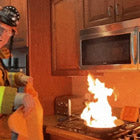 Fire
Fire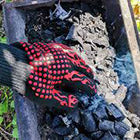 Safety
Safety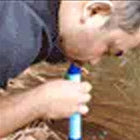 Survival
Survival Protection
Protection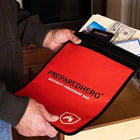 New
New
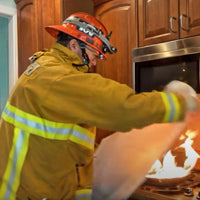 Fire
Fire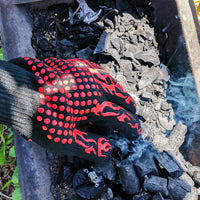 Safety
Safety Survival
Survival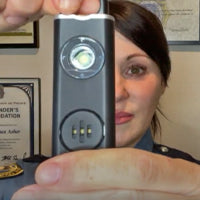 Protection
Protection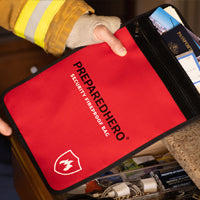 New
New
